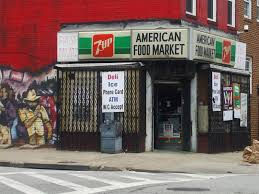How Baltimore’s Corner Stores Shifted: From Asian Hands to Arabic Names — and Who Was Left Out
- K Wilder

- Oct 28
- 4 min read
From Asian Hands to Arabic Names: How Baltimore’s Corner Stores Shifted — and Who Was Left Out

On a humid block in West Baltimore, the neon sign of a modest corner store casts a constant glow over the stoop. Thirty years ago, customers would have recognized a Korean surname on the awning; today, the same counter is run by a family with roots in Yemen. The aisles still hold the same essentials—soda, cigarettes, fried chicken by the box—but the shift in ownership tells a larger story about how capital, migration networks and policy choices shape who gets to own the businesses that anchor Black neighborhoods.
Waves of outsiders, one local effect
In Baltimore, immigrant entrepreneurs have long stepped into economic ground that corporate chains abandoned. Johns Hopkins and city mapping projects count more than 600 corner stores across Baltimore—micro-retail nodes that function as neighborhood groceries, social posts and de facto service centers for residents with limited supermarket access. Those shops were often founded by Korean and Chinese families beginning in the 1970s and 1980s; their labor, immigrant credit practices and willingness to run thin-margin, long-hour businesses established a retail network in the city’s poorest blocks.
As those first-generation Asian owners aged and their children moved into professional careers, many chose to sell. In a number of American cities—from New York to Detroit to Baltimore—the buyers who stepped in most often were newer immigrant groups: families from Yemen, Palestine and other Arab or Muslim-majority countries who arrived with their own kinship financing, community knowledge and sometimes transnational supply links. Coverage of bodega culture in other cities has documented how Yemeni and Arab families have grown to occupy a second wave of small-store ownership in urban cores.
l
Not a neutral exchange: who has access to capital
The result on the ground looks like a steady replacement of one group of “outsider” owners for another—while Black residents, who make up a majority of Baltimore’s population, remain disproportionately absent as owners. That absence is not for lack of desire. Instead, it reflects structural gaps in wealth, lending and intergenerational capital.
The Urban Institute’s “Black Butterfly” analysis mapped investment flows across Baltimore and found stark disparities: neighborhoods that are majority Black receive far less small-business lending and commercial investment than whiter parts of the city. The report finds that in many investment categories, majority-Black neighborhoods received a fraction of the dollars directed elsewhere—an inequality that helps explain why immigrant owners with family networks and rotating-credit options are often better positioned than longtime Black residents to buy a storefront when it becomes available.
Local studies and city equity reports reinforce the point: Baltimore’s racial wealth divide leaves many Black households with far lower median incomes and far less liquid capital to use as down payments or collateral for small commercial loans. That gap matters in a business where startup and acquisition costs are tight and margins are thin.
How immigrant networks matter
Researchers of immigrant entrepreneurship note that successive waves of newcomers often rely on informal financing—family loans, rotating credit associations, community charitable lending and knowledge transfer from relatives already in the trade. These networks lower the effective cost of entry and spread risk across households. Immigrant buyers also sometimes benefit from higher rates of intra-community hiring and a willingness to accept low early returns while a business stabilizes—advantages that are mechanically difficult for many Black Baltimoreans to replicate given the city’s historic capital gaps.
The consequences for neighborhood power and wealth
Corner stores are not just places to shop. They are neighborhood institutions—places where jobs, cash flow and small-scale wealth can accumulate. When ownership exits to people who don’t live in the block or to groups with separate social and financial networks, those economic benefits can leave with it. That’s why activists and scholars who use the “Black Butterfly” frame point to ownership as a lever: unless lending, training and acquisition supports change, the pattern of outside ownership will likely continue.
What a different handoff would require
Community organizers and local policy analysts suggest concrete steps to enable more Black ownership of neighborhood storefronts:
Targeted acquisition financing. Dedicated funds—structured as low-interest loans or revolving acquisition pools—could bridge the initial capital gap when a store hits the market. Blends of CDFI capital, philanthropic grants and city-backed loan guarantees could make purchases feasible where market lenders won’t.
Wraparound technical assistance. Programs that pair bookkeeping, SNAP/WIC enrollment help, vendor procurement assistance and refrigeration or fixture grants increase a buyer’s chance of success; Johns Hopkins and the Baltimore Healthy Stores work have already shown how technical supports can shift inventory toward healthier items and strengthen operations.
Succession and pricing interventions. Encouraging aging owners to offer seller financing, longer escrow periods, or community-preferred pricing can make handoffs possible without large upfront sums.
A city of mixed results
There are local examples that complicate a neat narrative. A few Arab- and Muslim-owned stores have invested in their neighborhoods and hired locally; some Asian-founded stores were long-term anchors who lived in the city but didn’t hire locally . There are also rising numbers of Black entrepreneurs starting or converting stores such as Team Loew corner store in West Baltimore —the few success stories remain exceptions rather than the rule. But the dominant arc in many Baltimore blocks has been the transfer of ownership between outsiders rather than from outsider to resident.
What it means going forward
If Baltimore wants neighborhood businesses to build local wealth, it must treat store ownership as economic infrastructure—not simply a merchant transaction. That means rewiring how small-business capital flows, amplifying technical assistance, and creating acquisition channels that prioritize residents. Otherwise, the plexiglass counters on East and West Baltimore blocks will continue to reflect the city’s broader investment gaps: the register rings, but the profits and power remain mostly out of reach for those who live next door.
Sources and further reading (selected)
Johns Hopkins / Bloomberg American Health Initiative: “Bringing Better Food to Baltimore’s Corner Stores” (2023) — on corner-store density and healthy-stores efforts.
Johns Hopkins research and pilot evaluations of Baltimore Healthy Stores interventions.
Urban Institute — The Black Butterfly: “Neighborhood investment flows in Baltimore” (2019) — analysis of racial disparities in small-business lending and neighborhood investment.
Reporting and features on Yemeni and Arab bodega ownership nationally (for patterns in New York, Detroit and elsewhere).
Baltimore City Office of Equity and Civil Rights: Racial wealth divide reports and local data.

















Comments